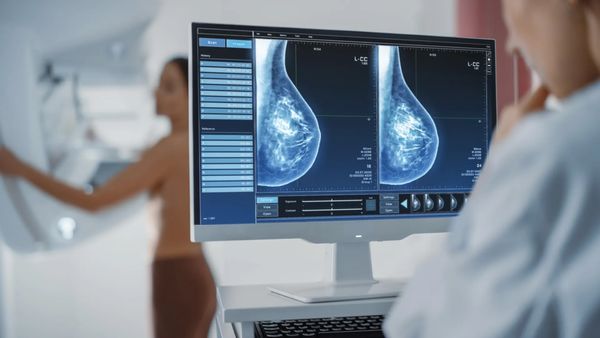
.png?fit=outside&w=1600&h=900)
Advancements in breast cancer research
the importance of early detection
St. Vincent Regional Hospital
Breast cancer affects 1 in 8 women in their lifetime, making it one of the most pressing health concerns for women. However, thanks to improved awareness, early detection, and advancements in treatment, survival rates have significantly improved over the years. According to the American Cancer Society (ACS), the 5-year survival rate for breast cancer is now 90-percent, and when detected early, that rate can be as high as 99-percent.
“Breast cancer remains the most common cancer in women, and early detection continues to be key in improving survival rates,” explained Dr. Troy Fiddler, a medical oncologist with Intermountain Health St. Vincent Regional Hospital - Cancer Centers of Montana. “One of the most effective tools in early detection is the mammogram. Mammograms are X-ray images of the breast that can detect tumors and abnormalities before they can be felt, often at a stage when treatment options are more effective and less invasive.”
.jpg?fit=outside&w=1200&h=1500)
Dr. troy fiddler, oncologist
Starting at age 40, all women should get a yearly mammogram. For women at a higher risk of breast cancer because of family history or other factors, screening may start earlier and be more frequent. Women should talk with their doctor about getting a mammogram sooner.
Click here (svh.org/mammography) to make an appointment for your screening mammogram today.
Latest Research in Breast Cancer
Breast cancer research has made remarkable strides in recent years, providing new hope for patients and their families. One of the most significant advancements is the development of targeted therapies.
“Unlike traditional treatments such as chemotherapy, which affect actively growing cells in the body, targeted therapies focus specifically on mutations harbored in cancer cells, leading to fewer side effects and more effective outcomes,” Dr. Fiddler said. “New drugs have entered the market in recent years and have revolutionized treatment for many types of breast cancer.”
Another area of research is in immunotherapy, which leverages the body’s immune system to fight cancer. Immunotherapy has shown promising results in treating other types of cancer, and researchers are exploring its potential for breast cancer patients, particularly those with triple-negative breast cancer, which has fewer treatment options.
Advances in genetic testing are also helping to personalize breast cancer treatment. Genetic tests can now identify specific mutations, such as BRCA1 and BRCA2, which increase the risk of developing breast cancer. Women with these mutations can take preventative measures, such as enhanced screening, medication, or preventive surgery, to reduce their risk explained Dr. Fiddler.
.png?fit=outside&w=1600&h=900)
Annual Screening Mammograms
In addition to treatment advances, there is ongoing research focused on improving screening technology. 3D mammography, also known as tomosynthesis, is becoming more widely available. This newer imaging technology creates a more detailed, three-dimensional picture of the breast, improving accuracy and reducing the chances of false positives or missed diagnoses.
“Despite the advancements in treatment, early detection through mammograms remains one of the most critical tools in the fight against breast cancer,” said Dr. Kalie Adler, DO, a diagnostic radiologist with Intermountain Health. “Regular screening allows for cancer to be caught in its earliest stages when it is most treatable. Women who skip or delay annual screenings face a higher risk of being diagnosed at a later stage, when the cancer may be more advanced and harder to treat.”
.png?fit=outside&w=1600&h=900)
Your Breast Health & When to See a Doctor
You can stay aware of any changes happening to your breasts by visiting your care provider for your annual clinical breast exam and contacting them immediately if you see or feel:
- A lump or lumps in one or both breasts
- Pain or tenderness
- Fluid leaking from a nipple (when you’re not making milk for breastfeeding)
- A nipple starts pulling in instead of poking out (becomes inverted)
- The skin of your breast changes (such as turning red or puckered)
Many breast changes or lumps are not cancer and might be caused by hormonal changes or other conditions.
Learn more at svh.org/mammography.
More from the Experts at St. Vincent Regional Hospital
About St. Vincent Regional Hospital
Founded on our mission of compassionate care 125 years ago, St. Vincent Regional Hospital, part of Intermountain Health, has grown into one of Montana’s largest comprehensive hospitals, serving the healthcare needs of over 400,000 people in our four-state area. Continuing to respond to the needs of our community, we have been recognized as an innovator in trauma, heart, neurological and cancer care. At St. Vincent and Intermountain Health, our 12 primary care clinics, and specialty clinics in and around the Billings area, our goal is to help you live the healthiest lives possible. This also includes caring for the region's youngest patients. We opened the region's first Pediatric Intensive Care Unit staffed 24/7 by Pediatric Intensivists and the only Pediatric Surgery program serving eastern Montana, northern Wyoming, and the western Dakotas.
125 Years of Caring for You
St. Vincent is proud to be Billings' first hospital, caring for generations in our community. Hear the story of how a group of brave Catholic sisters brought healthcare to Billings and how we continue our mission to help you live your healthiest life. Click HERE to watch.








































